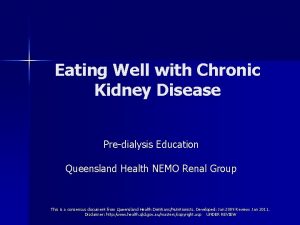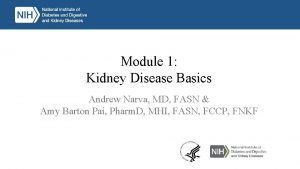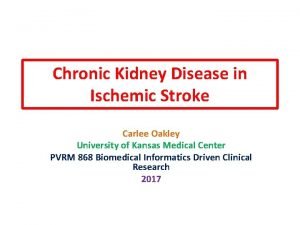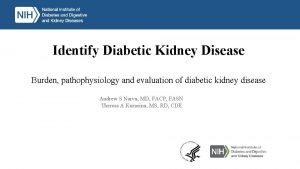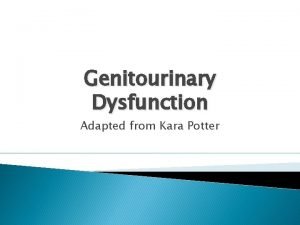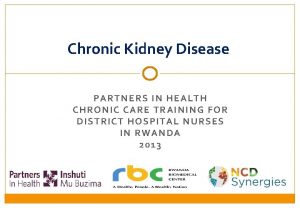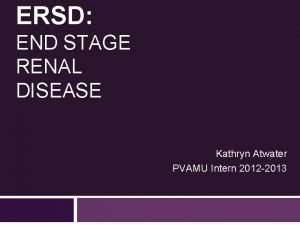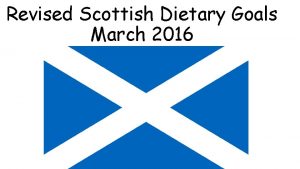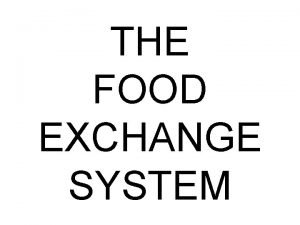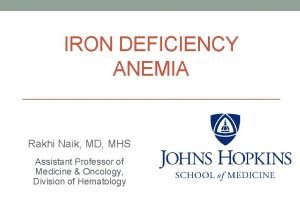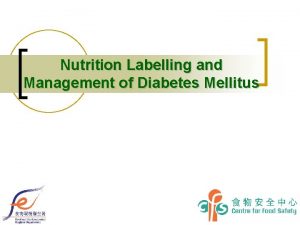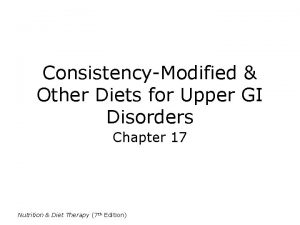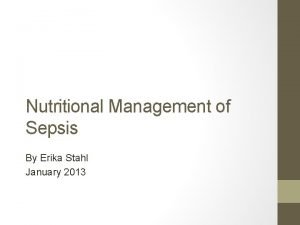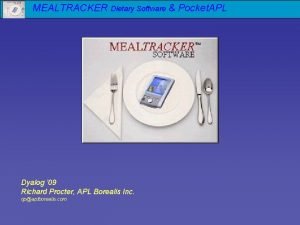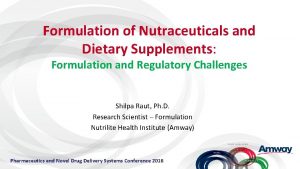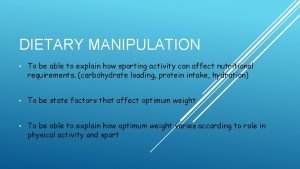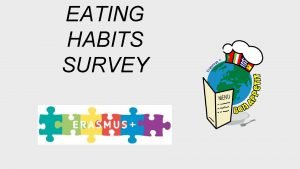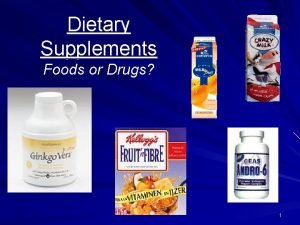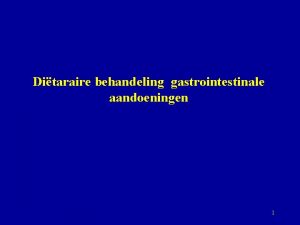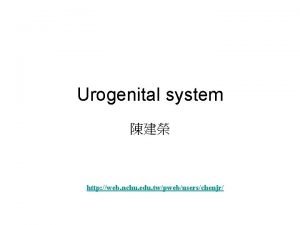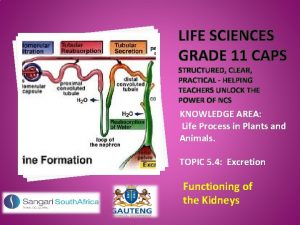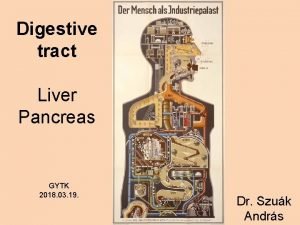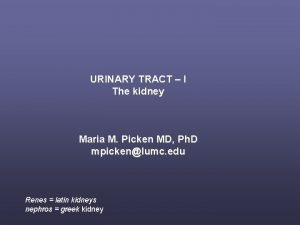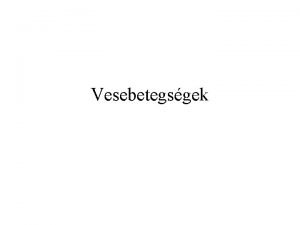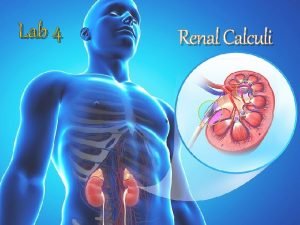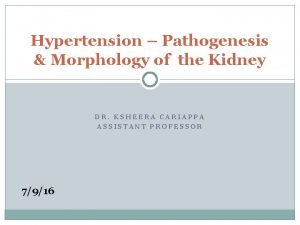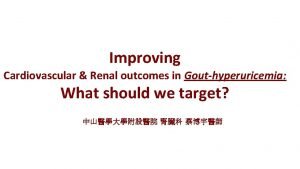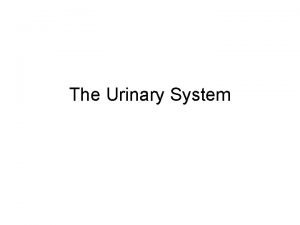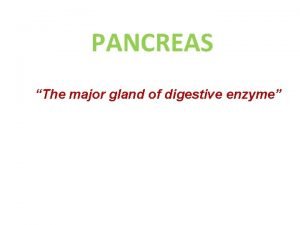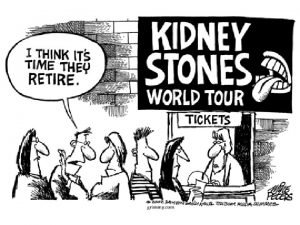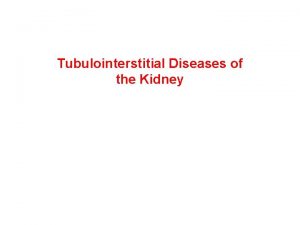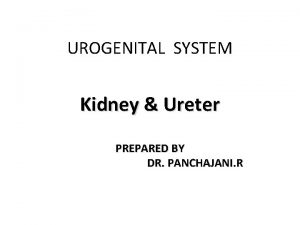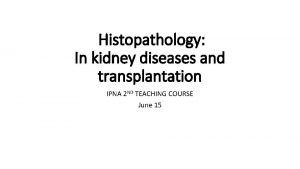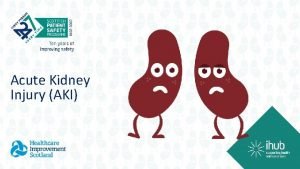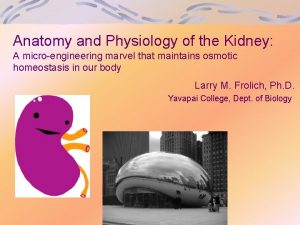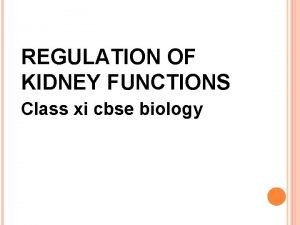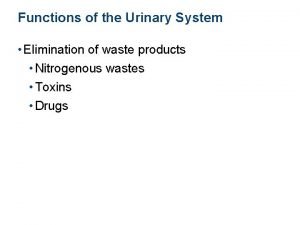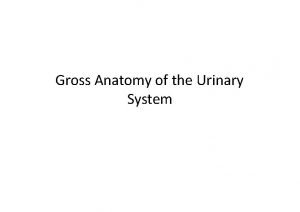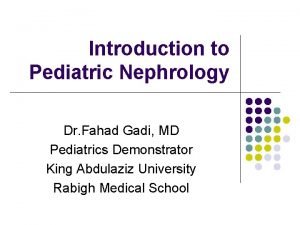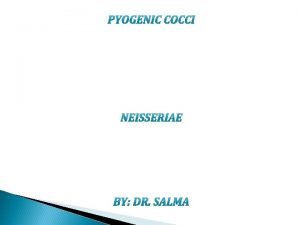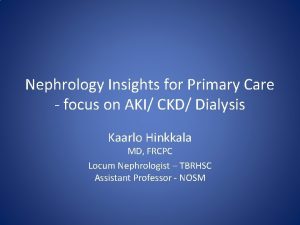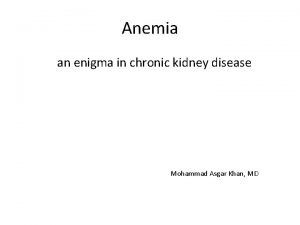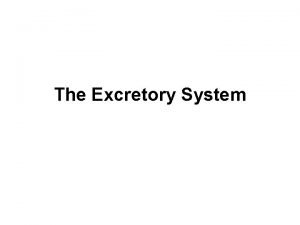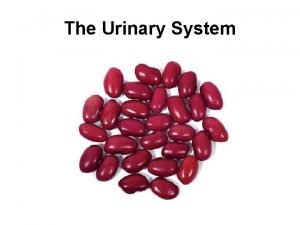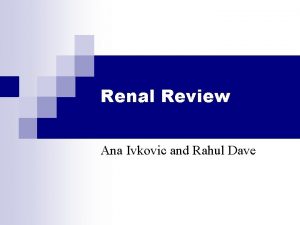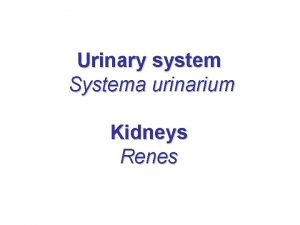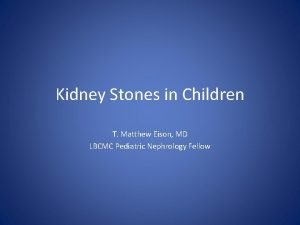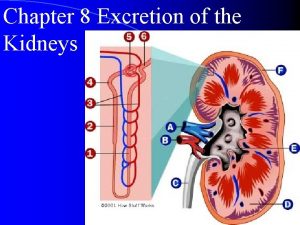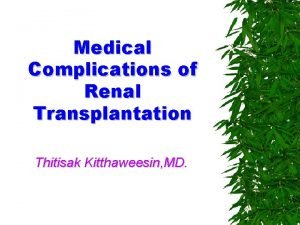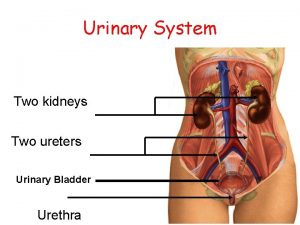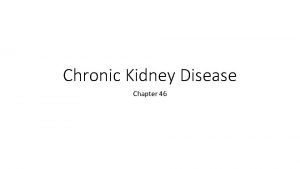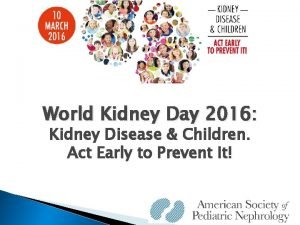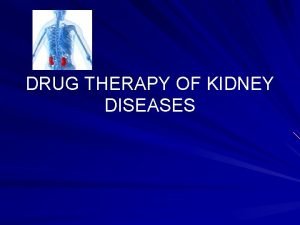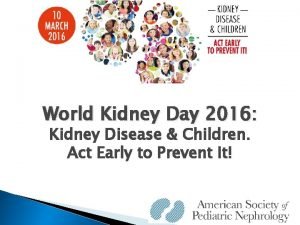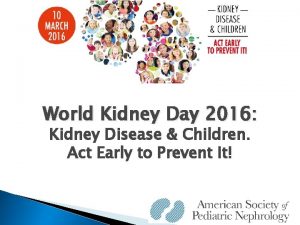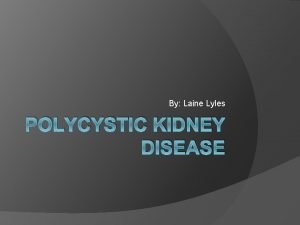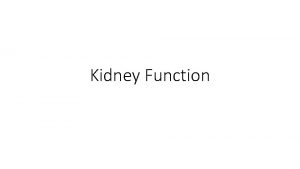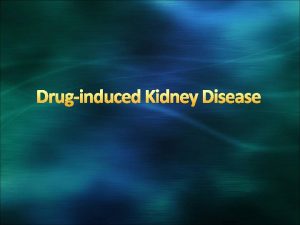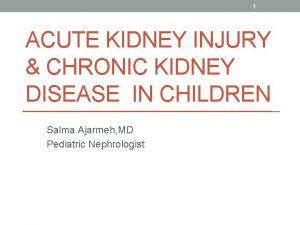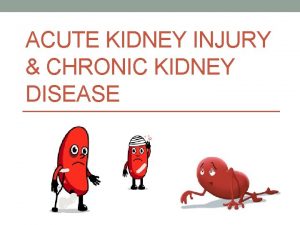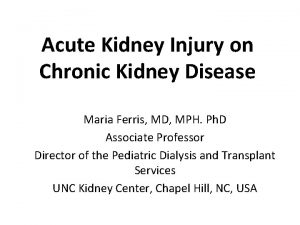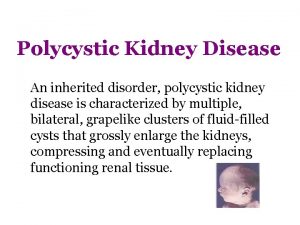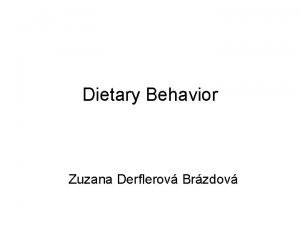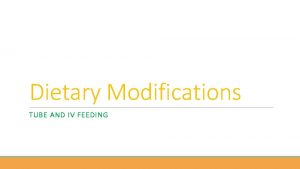Dietary Approach To C Kidney Disease Dr Anita








































































- Slides: 72

Dietary Approach To C Kidney Disease Dr Anita Saxena MD, Ph. D (Cambridge) Associate Professor Department of Nephrology SGPGIMS, Lucknow. India

Nutrition In Renal Disease Is Complicated • The term “Renal disease” embraces a number of clinical conditions whose common feature is decrease in GFR. • Another common feature that these conditions share is malnutrition but each condition has a different approach in terms of nutritional therapy.

Definition of Chronic Kidney Disease • Chronic Kidney Disease is defined as kidney damage for ≥ 3 months as defined by structural or functional abnormalities of the kidney, with or without decreased GFR. • GFR ≤ 60 ml/min/1. 73 m 2 with or without kidney damage. • There are 5 stages of CKD depending upon GFR (≥ 90, 60 -89, 59 -30, 29 -15, <15) ml/minute.

Why Do We Need To Modify Diets? • As kidney disease progresses, the capacity to respond to changes in intake of nutrients and water becomes less flexible. • Solute and water excretion per nephron increases, but the fewer number of functional nephrons leads to a more restricted range of solute and water excretion. • When diet exceeds daily protein requirement, the excess protein is degraded to urea and other nitrogenous wastes and these products accumulate in the body. • Because the severity of uremic syndrome is proportional to the accumulation of these waste products and ions, therefore, dietary intake needs to be adjusted.

Why Modify Diets? Cont. . • In kidney failure nutritional therapy allows good control of several consequences of the disease. Nausea /Vomiting Anorexia Initiation of dialysis

When Does Protein-Energy-Wasting Set In?

The MDRD Study: Association Between Dietary Intake And GFR and Serum Albumin and GFR With GFR< 60 m. L/min/1. 73 m 2 dietary protein and energy intake decreases and serum also albumin decreases (presence of inflammation). Males, solid lines; Females, dashed lines

When Does Protein-Energy-Wasting Set In? contd…. . • PEW most likely occurs during CKD stage 3 or even earlier partially due to inadequate nutritional management in predialysis phase and becomes clinically evident when GFR is < 15 -10 ml/min. • 20 -70% patients on Maintenance Dialysis show signs of PEW.

Malnutrition is Multifactorial Loss of Nutrients & Water soluble Vitamin in Dialysate Uremic toxicity Dietary protein & energy intake Inadequate Dialysis dose Anemia loss of blood due to GI bleed, frequent blood sampling Declining Residual Renal Function level of counter regulatory hormones Glucagon, PTH Anorexia Loss of taste Unpalatable diets Malnutrition Inflammation Infection Superimposed illness Presence of Comorbidity Hormonal disorders Resistance to anabolic hormones Metabolic Acidosis

Markers of Protein-Energy Malnutrition (Predictors of Morbidity And Mortality in CKD) �Progressive weight loss BMI <22 kg m 2 >60 years �Wasting of fat and skeletal muscle tissues reduced muscle mass 5% in 3 m � Reduction in serum protein Serum albumin level <3. 8 g/d. L �Serum pre-albumin level <30 mg/d. L �Serum cholesterol level <100 mg/d. L A Low dietary protein intake <0. 6 g/kg/d or <0. 8 g/kg/d on MHD and energy intake <25 kcal /kg/d for at least 2 months

What Problems Are Unique To Patients with CKD?

Does CKD Have An Influence On Gastrointestinal Tract? ESPEN Guidelines on Enteral Nutrition: Adult Renal Failure N. Canoa etal Clinical Nutrition (2006) 25, 295– 310 1. Uraemic syndrome is associated with loss of appetite and a variety of gastrointestinal adverse effects, which results in reduced nutritional intake. Anorexia 35% - 60% of MD Patients 14406 120 HDHD pats (DOPPS) 223 HD pats 34 HD pats 1846 HD pats (HEMO) 331 HD pats 307 HD pats 73 HD pats Merkus et al. 1999 106 PD pats 66 CKD 5 predialysis pats 238 CKD 5 predialysis pats 0 Lopes et al. 2007 Carrero et al. 2007 Muscaritoli et al. 2007 Burrowes et al. 2005 Kalantar-Zadeh et al. 2004 Curtin et al. 2002 Virga et al. 1998 25 Murtagh et al. 2007 Curtis et al. 2002 50 75 100%

Does CRF Have An Influence On Gastrointestinal Tract? ESPEN Guidelines on Enteral Nutrition: Adult Renal Failure N. Canoa etal Clinical Nutri(2006) 25, 295– 310 2. Patients with CRF Impaired gastric emptying Impaired intestinal motility Disturbances of digestive and absorptive functions, and Alterations in intestinal bacterial flora (Kang JY. 1993. Dig Dis Sci 38: 257– 68) Delayed intestinal fat absorption (Drukker A Nephron 1982; 30: 154– 60). Gastroparesis is most pronounced in patients with diabetic nephropathy.

What Problems Are Unique To Patients with CKD? 3. Poor nutrition in general. 4. Lack of proper diet counseling and poor monitoring of nutritional status.

Problems Are Unique To Patients with CKD? 5. Hyperglycemia 6. Hyperlipidemia 7. Cardiovascular involvement

Problems Are Unique To Patients with CKD? 8. High incidence of infections 9. Late initiation & Inadequate dialysis.

Nutritional Requirements of CKD Patients

CKD Stages 1 -4 Low-protein diet (LPD) + Fluid Management Low-protein diet (LPD) is a conservative treatment in patients with chronic kidney disease (CKD) to improve uremic symptoms and slow progression of renal dysfunction. (Brenner BM, Meyer TW, Hostetter TH N Engl J Med 307: 652– 659, 1982. )

Fluid Management Input and Output Charting Oral Intake + IV infusions & Urine Output charting Fluid intake: Water taken with meals, medications or otherwise Tea, Coffee Milk Curd And any other liquid Fluid Prescription: Previous 24 hour urine output + 500 ml if patient is dry • If patient is edematous: 24 hour urine output + 300 ml

Nutrient Requirements for Stage 1 Kidney Damage (presence of protein in urine) normal GFR >90 m. L/min/1. 73 m 2 Protein: 0. 8 g/kg/d Non Diabetics Energy: 30 -35 kcal/kg/d < 60 years 30 kcal/kg/d > 60 years Diabetics : <30 kcal/kg/d Water soluble Vitamins and minerals as per RDA Principle Is Restrict Protein Do Not Say No To Protein

Prescribe Low Potassium Diet Potassium Intake in CKD 1 m. EQ/kg/day Hyperkalemia (high serum K+) Can cause arrhythmia Prescribe Low K foods: • Foods containing <100 mg K /100 g • Apple, banana, guava, pear, orange, papaya

Reduce Potassium intake Leach/remove potassium from vegetables by soaking chopped vegetables in luke warm water for half an hour. X X Avoid green leafy vegetables, tomatoes, sweet lime, lemon, carrots, raw salad, mango, dry fruits fruit juice, vegetable soup, X X coconut water. X X X

Low Sodium Diet for better control of blood pressure& edema Sodium intake in CKD <2. 4 g/d (AHA/KDOQI Guidelines for control of Hypertension) 1 tsp=5 g =2. 5 g Na Avoid Foods containing Sodium>100 mg/100 g Avoid canned foods/fruits/Pickles/fruit jam

Nutrient Requirements for Predialysis Stages 2 , 3 4, 5 Kidney Damage With Mild Decrease in GFR To Severe Reduction In GFR 60 -89, 30 -59; 15 -<30 m. L/min/ 1. 73 m 2 Nutrient Requirement (conservative management) Low protein 0. 6 g/kg/d Guideline 24 Those unable to accept 0. 75 g/kg/d Energy 30 -35 kcal/kg/d (35 < 60 years; 30 > 60 years; Guideline 25 Phosphorus 800 -1000 mg to prevent hyperphosphatemia. Non-calcium based phosphate binder with meals to prevent soft tissue calcification. Calcium 1000 -1500 mg/d Sodium <2. 4 g/d Potassium 1 m. Eq/kg Cholesterol <200 mg/d. Avoid egg yolk Water soluble Vitamins and minerals/ RDA Anemia Treat anemia with folic acid, B 12, iron supplements and ESA

Do Not Advise Your Patients Not To Take Protein. Put them on Low Protein 0. 6 g/kg/d Weight of patient = 50 kg 50 x 0. 6 = 30 g of protein 1 2 Milk 150 ml = 4. 5 g/protein 3 Dal 1 bowl = 6 g protein Chappati=2 g 8 chappaties = 16 g Rice: 50 g raw = 3 g Total 29. 5 g 4

Protein intake in Children K/DOQI Guideline 6 2009 CKD stage 1 -3 dietary protein intake 100% to 140% of the DRI for ideal body weight. CKD stages 4 to 5 100% to 120% of the DRI Energy intake should exceed RDA for age at least initially. Prescribe “catch up” energy supplements to achieve RDA or Higher as per chronol age for children who demonstrate energy malnutrition. If patient does not gain weight recommend Energy intake based on height age.

MDRD Study Low Protein Diet + Keto Analogues • Delay progression of kidney disease in the Predialysis period. Reduce uremic symptoms Preserve residual renal function Delay onset of dialysis Preserve nutritional status. Improve metabolic complications due to renal insufficiency • Essential amino acid tablet contain all amino acids essential for uremic patients (50 mg /tablet; dose 5 mg/kg/d). (Barsotti G, etal. Kidney Int 24: Suppl 16, S 278–S 284, 1983. Gretz N, Korb E, Strauch M Kidney Int 24: Suppl 16, S 263–S 267, 1983) COST

Nephrotic Syndrome Dietary Recommendations: Dietary Low fat, Low salt diet+ Fluid restriction • Restrict Fluid: depending upon presence of edema • Energy: 35 kcal/kg b. w. /d • Protein 0. 6 -0. 8 g/kg b. w. with 1 g for each gram of albumin lost in urine. • In children protein - according to RDA for chronological age. • Restrict Sodium to 2. 4 g/d. • Low Fat diet: Fat <30% of total calories (PUFA 10%) • Cholesterol < 200 mg/d • Soy protein is beneficial for kidneys • Avoid egg yolk, cream, red meat, fried foods

Diabetic Nephropathy Dietary Recommendations (Up-To-Date, 2006) 1. Protein intake of 0. 8 g/kg/d reduces albuminuria and stabilizes kidney function (Egg white HBV for protenuria). 1. Achieve Normoglycemia 2 Manage dyslipidemia 3. Manage Weight 4. Good Blood Pressure control (<130/80 mm. Hg) 2. As GFR decreases restrict protein 0. 6 g/kg/d. 3. Energy: <30 kcal/kg/d for weight management. 4. Total fat should be restricted: 30% total Kcals. (<10% calories from SFA; <10% calories from PUFA; 10 -15% calories from MUFA) 5. Dietary cholesterol <200 mg daily along with n-3 polyunsaturated fats.

Diabetic Nephropathy Dietary Recommendations (Up-To-Date, 2006) 1. Advise small meals at frequent intervals that consist of low-fat and complex carbohydrates. 2. 3 meals and 2 snacks BF/Dinner 3. Avoid meals with high-fiber content.

Pregnancy, Diabetes and CKD No studies on Preg Diabetics CKD Stage 5. Strategies for management of hyperglycemia, hypertension, and dyslipidemia may be extrapolated from the recommendati ons for women with earlier stages of CKD. Discontinue Treatment of DKD with RAS inhibitors Hb. A 1 C as close to normal as possible (<1% above upper limit of normal) Use Insulin to control hyperglycemia if necessary Liberalize dietary protein 1. 0 -1. 2 g/kg preconception Weight/d Treat High blood pressure >140 -160/90 -105 mm Hg Target BP <130/80 mm Hg because of CKD. Avoid hypotension

RENAL STONE DISEASE

RENAL STONE DISEASE Composition: calcium, oxalate, phosphate, uric acid • • • Drink plenty of fluid: 3 -4 litres/day (half of which should be water) Continuous intake rather than acute bursts of drinking will ensure required urinary SG of <1. 01. Take a glass of water before going to bed to maintain specific gravity < 1. 01. Avoid hard tap water In adults, urine volume should be>2 L/day Low salt diet Low protein diet Prefer vegetarian diet. If urine p. H >6. 0 avoid citrate supplements. Prefer refined cereals and flours.

RENAL STONE DISEASE Composition Calcium, Oxalate, Phosphate, Uric acid • Patients can take a total of 1000 -1200 mg of calcium/day from natural foods. • Milk intake should not exceed 2 glasses/day. X • Avoid calcium supplements as tablets. • Allow lemon juice. • Avoid orange juice as it raises oxalate level. • Avoid cola beverages. • Avoid Cranberry juice. • Calcium phosphate stones are treated successfully with high-phosphate diets. In this case prefer whole grains. • Weight reduction and all forms of physical Cranberry. Juice activity should be encouraged. � � X X X

Gout (Hyper-Uricemia ) Avoid Foods Containing High Uric Acid Low protein diet Poultry and organ meats • Fish Herring, Fish Roe, Salmon, Sardine • Kidney, Liver, Meat Soup Extracts • Legumes (Dry Peas Beans, Soyabean) Mushrooms Asparagus.

Autosomal Dominant Polycystic Kidney Disease (ADPKD) LOW SALT RESTRICT FLUID CONTROL BLOOD PRESSURE

Autosomal Dominant Polycystic Kidney Disease (ADPKD) • Low Protein 0. 8 g/kg/d • As creatinine increases reduce it to 0. 6 g/kg/d • Low SALT diet • Restrict Fluid intake • Good control of Blood pressure • Long Term Coverage With Antibiotics if infected • Soy protein (slows progression of PKD inanimals) (Aukema, et al. J Am Soc Nephrol. 10: 300 -308, 1999) • Avoid foods with higher amounts of oxalic acid. (spinach, rhubarb, beets, eggplants, cocoa, and chocolate) • Omega-3 -fatty acids (Flax seeds/oil ): antihypertensive, lipid-lowering and antiinflammatory effects. SOY

Management Of Patients On Maintenance Dialysis Hemodialysis CAPD

Malnutrition At Initiation Of Dialysis Is A Strong Predictor Of Subsequent Increase In Relative Risk Of Death Carrero JJ, J Renal Nutr 2013 Vol 23, issue 2, Pages 77 -90 Hakim RM and Lazarus JM. JASN 1995; 6: 1319– 28 Abdu A et al Afr J Clin Nutr 2011; 24(3): 150 -153 Flanigan MJ. Perit Dial Int. 1998; 18: 489 -496.

Chung SH Peritoneal Dialysis International, Vol. 20, pp. 19– 26 By Kaplan–Meier analysis, patient survival rate is significantly lower in malnourished patients than in normal patients (67. 1% vs 91. 7% p = 0. 02) �Malnutrition was present in 45% of 91 patients commencing CAPD as assessed by SGA. Initial nutritional status appears to exert a powerful influence on CAPD patient survival.

CANUSA Study NDT 1998; 13 (Suppl 6): 158– 63. Relative risk of death increases with 1. Lower serum albumin and 2. Worse nutritional status as assessed by SGA and %LBM

Loss Of Protein HD/session 1 -3 g/session • • CAPD/Day 5 -15 g/24 h 4 g of which is albumin Peritonitis/24 h 15. 1 gm Protein intake should be increased to > 1. 3 1. 5 g/kg/d The loss of serum proteins in stable continuous ambulatory Estimating energy, protein & fluid requirements for adult clinical conditions June 2012 Qeensland Govt peritoneal dialysis (CAPD) patients averages 5 g per 24 hours, 4 g of which is albumin Krediet RT, Zuyderhoudt FM, Boeschoten EW, Arisz L: Peritoneal • permeability to proteins in diabetic and non-diabetic continuous ambulatory peritoneal dialysis patients. Nephron • 42: 133– 140, 1982. Imholz AL, Koomen

Dietary Protein & Energy Intake for Patients on MHD NKF-K/DOQI Guideline 15, 16 n n S Albumin ≥ 4. 0 g/d. L Guidelines 3 S Prealbumin ≥ 30 mg/d. L Guidelines 4 Prescribe 1. 2 g/kgbw/d protein to clinically stable patients on HD Guideline 15 Prescribe 1. 3 g/kgbw/d protein to patients on PD necessary to ensure neutral or positive nitrogen balance. Guideline 16 At least 50% of protein should be of HBV Energy 30 -35 Kcal/kg/d depending upon age <60 or >60 y

Increasing Protein Intake in Dialysis: The Phosphate Paradigm Protein has linear relation with phosphate 1 g protein brings 13– 15 mg phosphate (of which 30– 70% is absorbed through the intestinal lumen). Mortality decreases when protein intake increases up to 1. 4 g/kg/day (lower panel) despite a slight increase in serum phosphate (Shinaberger JH et al. , 1982). n. PNA, appearance.

Increasing Protein Intake in Dialysis: The Phosphate Paradigm • Mean peritoneal phosphate clearance (L/wk/1. 73 m 2 BSA) according to peritoneal membrane transport category and peritoneal dialysis modality. CAPD, continuous ambulatory peritoneal dialysis; CCPD, continuous cyclic peritoneal dialysis; H, high transport category; HA, highaverage transport category, LA & L: combined low-average and low transport category. 1 -day peritoneal dialysis clears ~300 mg phosphate. • 1 regular hemodialysis session clears 500– 600 mg phosphate • This results in a net balance of 1800 mg every other day in HD pateints, an amount that cannot be eliminated through dialysis • Phosphate binders are a must for such a patient.

Patients on Maintenance Dialysis Require Extra Protein Supplement Insufficient Protein Intake • Renal Specific Protein Supplements in powder or biscuit form. The Renilon Multicentre Trial: Use of a renal specific oral supplement by HD patients who have low protein intake does not increase need for phosphate binders and prevents decline in nutritional status and quality of life. Serum albumin and prealbumin changes associate positively with the increment in protein intake (The Renilon Multicentre Trial Fouque D etal NDT. 2008 Sep; 23(9): 2902 -10) • Peptide based supplements for sick patients.

Nutrition Supplements in Dialysis Patients: Use in Peritoneal Dialysis Patients and Diabetic Patients R Poole Adv Peritoneal Dial, Vol. 24, 2008 Serum albumin (SA) levels before, during, and after the nutrition supplement in hemodialysis (HD) and peritoneal dialysis (PD) patients. Daily Supplement: 20 – 30 g protein and approx 500 calories Significant improvement in albumin level during months 4 – 6 in HD patients but not in PD Patients. It takes 3 months of supplementaion to show improvement in S albumin In PD patients s albumin levels declined after supplementation was stopped

Guideline 19 – Indications for Nutrition Support in dialysis dependent patients • If oral supplements are not tolerated or effective and malnutrition is present (<20 Kcal/kg/d and Protein intake is <0. 8 kg/g/d) consider tube feeding to increase protein intake. • Overnight supplement can improve nutritional status and overall wellbeing. • Bolus feeding: Start 50 -100 ml feed, then increase to 300 -400 ml per feeding. • Continuous feeding: Start with 2050 ml/hr, then increase 20 ml every 2 -8 hrs until requirement is met.

En Practical Rules For Preventing Protein Energy Wasting/ Malnutrition

1. Monitor Nutritional Status Identify Nutritional deficiencies before they become clinically evident. (K/DOQI, AJKD. 2000; 35: S 1 -140. Enia G, etal. NDT. 1993; 8: 1094 -1098

Monitor Nutritional Status (Predialysis* and Dialysis Depenedent** Patients) Measure Frequency of Measurement Total protein 3 monthly* Monthly** Serum albumin 3 monthly* Monthly** Na 3 monthly* Monthly** K 3 monthly* Monthly** Ca 3 monthly* Monthly** P 3 monthly* Monthly** % of usual post-drain body weight Monthly** % of standard (NHANES II) body weight Monthly** Subjective Global Assessment Every 6 months Dietary interview and/or diary Monthly n. PNA Every 3 -4 months Anthropometry As needed

Prevent Monitor Treat Complications

Slow Progression of CKD • Reduce Albuminuria to slow progression of CKD, particularly in diabetics. • Supplement with vitamin B complex (AHA) • Folic Acid, Vitamin B 6 and B 12 supplements to prevent hyperhomocystenemia • Serum albumin < 4. 0 g/d. L, prior to initiation of dialysis, predict morbidity and mortal(Kaysen et al, 2008).

Slow Progression of CKD • Control Blood Pressure to • • • slow progression of CKD and lower CVD risk. Target BP ≤ 130/80 mm. HG Limit sodium intake. Prescribe diuretics to treat fluid overload Advise Weight reduction if required. Monitor serum potassium in patients on renin angiotensin aldosterone system (RAAS) antagonists. Limit dietary potassium intake.

Slow Progression of CKD Manage Diabetes • Target Hb. A 1 c should be <7. 0% (ADA Guidelines 2007). • Good control of newly diagnosed diabetes may slow progression of CKD. • Blood glucose control may help slow progression of CKD (DCCT, 1993; UKPDS, 1998)

2. Correct Uremic Symptoms If patient is on dialysis individualize dialysis prescription. Give adequate dialysis Maintain Kt/V urea of 1. 2 for HD 1. 7/week CAPD ADEMEX Trial (2001)

Nutritional Effects Of Increasing Delivered Dialysis Dose In Malnourished PD Patients had evidence of declining nutrition over 12 months With 25% increase in delivered PD dose for 6 months Total Kt/V 1. 67 1. 93 ( 18%) Wt, kg -6 m 0 +2 m +4 m +6 m p - 12 m 67. 4 68. 2 66. 6 65. 1 65. 3 66. 4 0. 18 27. 9 0. 94 27. 7 0. 85 27. 2 0. 81 26. 7 26. 8 27. 4 0. 84 0. 19 0. 23 1. 06 31. 6 1. 04 31. 2 0. 83 26. 7 0. 92 28. 7 0. 17 0. 03 P. albumin, g/L 35. 6 34. 3 31. 4 32. 8 0. 05 SGA 5. 7 5. 2 4. 0 4. 4 0. 15 MAC, cm n. PNA, g/kg/d DPI, g/kg/d Oral calories, cal/kg/d 30. 8 31. 7 Open, prospective, longitudinal intervention: Davies et al K Int 57: 1743, 2000

3. Treat Anorexia: Eliminate/Treat any potentially reversible or treatable condition or medication that might interfere with appetite or cause malnutrition. Phosphate binders may induce loss of appetite. Discontinue use of phosphate binders for 2 weeks to see if appetite improves. Discontinue use of iron supplements if there are repeated GI upsets Discontinue calcium supplements if bowel movements are irregular Reduce salt intake for better control of blood pressure to minimize requirement of antihypertensive medication.

Anorexia cont. . In patients on Peritoneal Dialysis Glucose Absorption from dialysate Induces abdominal discomfort Suppression of Appetite (patient absorbs 100 -200 g/d 300 -500 kcal/d ) Encourage patient to take small but frequent meals. Peritoneal Dialysate

Rule 4 Correct Of Metabolic Acidosis Reduce Protein Catabolism, Increase Albumin Synthesis Degradation Of Essential BCAA. Serum Bicarbonate level at 22 mmol/L Evaluate Monthly NKF/KOQI Guideline 13/14 Replace Sevelamer HCL With Sevelamer Carbonate To Prevent Acidosis

Rule 5. Practical Rules For Preventing PEW Treat comorbid conditions like diabetes, gastrointestinal disorders, and infection which increase malnutrition. Combined presence of co-morbidities such as cardiovascular disease and vascular complications in diabetic CAPD patients along with malnutrition increases mortality of PD patients. Dong J, Wang T, Wang HY. Blood Purif 2006; 24: 517– 23 The Impact Of New Comorbidities On Nutritional Status In CAPD Patients.

Treat Diabetic Gastroparesis: characterized by delayed gastric emptying & Upper GI symptoms Ajumobi AB , Griffin RA , Hospital Physician March 2008 Maintain Glucose levels below 180 mg/d. L Average blood glucose should not exceed 150 mg/dl (Use Insulin therapy) Prevent Hypoglycemia: Blood glucose should not be less than 110 mg/dl (to). � Prescribe Medium-chain triglycerides. �Avoid meals containing Fat to avoid delayed gastric emptying. � Give high-calorie liquid supplements if patient is not in Volume Overload. �if patient is sick consider parenteral nutrition.

6. Prevent Infections especially in PD To Maintain Good Nutritional Status Infections lead to ed appetite Impart Intense Exit site infection training to patient & attendant for maintaining hygiene. Peritonitis

7. Preserve Residual Renal Function for Proper clearance of middle molecules Anorexia In PD • Anorexia is more common in patients who have lost RRF and has significant independent effect on dietary protein intake. • Patients with RRF have higher mean DPI and n. PNA than patients without RRF (1. 08 ± 0. 31 vs 0. 89 ± 0. 31 g/kg/d and 62. 1 ± 12. 4 vs 54. 9 ± 15. 3 g. d). ( Wang etal JASN 2001 Nov 12 (11) 2450 -7) Every 1 ml/min/1. 73 m 2 increase in GFR associated with 0. 041 -fold increase in DPI and 0. 838 -fold increase in DCI. (Cross sectional study on 242 CAPD patients Caravaca etal 1999, Per Dial Int. Vol 19 350 -6 )

STATEGIES FOR PRESERVING RRF cont. . Avoid Contrast and Other Toxins Worsen renal function Avoid Nonsteroidal anti-inflammatory drugs, aminoglycoside antibiotics, and oral phosphate solutions. Aminoglycoside antibiotics used for treatment of peritonitis and catheter infections should be used with caution (ISPD). Prevent peritonitis, because peritonitis is also associated with a decline in RRF.

8. Anemia also causes generalized weakness & loss of appetite • Correct Iron Profile • Supplement Folic Acid • Correct Vitamin B 12 deficiency • Treat chronic infections and secondary hyperparathyrpoidism • Prescribe optimal dose of ESA/EPO • Use L-Carnitine in EPO resistant anemia.

9. Reverse Protein Loss Give High Protein Diet to Patients on Dialysis

: Rule 10. Practical Rules For Preventing PEW Daily Hemodialysis Increases Protein and Energy Intake Galland et al. Kidney Int 2001

TAKE HOME MESSAGE Prevent Malnutrition From Setting In

2. Monitor closely nutritional status and nutrient intake. 3. Individualize diet prescriptions. P ro te in of H ig h B io lo gi c al V al ue 1. Correct uremia and metabolic acidosis to prevent protein catabolism. 4. Do not completely stop protein intake. • Restrict Protein intake to 0. 6 g/kg/d in predialysis patients. 5. Ensure high protein diet for patients on Maintenance Dialysis. 6. Eliminate drugs which cause GI upset and anorexia.

T h a nk y o u

Foods With High Phosphorus Content Useful In Treating Stone Disease • Milk and milk products, khoa • liver, egg yolk, fish, meat products, soft drinks, whole grain cereals and flours, Mustard leaves cauliflower, • carrot peanut, • Kidney beans, soyabean, til water chestnut, . Chocolate dry fruits dry coconut
 Low potassium diet nemo
Low potassium diet nemo Albumin kidney disease
Albumin kidney disease Carlee oakley
Carlee oakley Albumin kidney disease
Albumin kidney disease Sighns of kidney problems
Sighns of kidney problems Symptomatic polycystic kidney disease
Symptomatic polycystic kidney disease Nephrology near atwater
Nephrology near atwater Natremia
Natremia Communicable disease and non communicable disease
Communicable disease and non communicable disease Theravada meal chant
Theravada meal chant Scottish dietary goals 2020
Scottish dietary goals 2020 Advantages of food exchange list
Advantages of food exchange list Dietary supplement questionnaire
Dietary supplement questionnaire Dietary acculturation
Dietary acculturation Iron deficiency anemia
Iron deficiency anemia Dietary management of diabetes
Dietary management of diabetes Dietary adjustments after a gastrectomy are influenced by
Dietary adjustments after a gastrectomy are influenced by Sepsis dietary management
Sepsis dietary management Mealracker
Mealracker Nutraceutical formulation
Nutraceutical formulation Dietary manipulation in sport definition
Dietary manipulation in sport definition Eating habits questionnaire for students
Eating habits questionnaire for students Vitamin k dietary sources
Vitamin k dietary sources Dietary supplements meaning
Dietary supplements meaning Lymfangiectasie
Lymfangiectasie Hong kong dietary guidelines
Hong kong dietary guidelines Theoretical models of counseling
Theoretical models of counseling Bandura's reciprocal determinism
Bandura's reciprocal determinism Waterfall strategy
Waterfall strategy Approach meaning in research
Approach meaning in research Multiple approach-avoidance conflict
Multiple approach-avoidance conflict Diagram for traditional approach
Diagram for traditional approach Datagram network and virtual circuit network
Datagram network and virtual circuit network Tony wagner's seven survival skills
Tony wagner's seven survival skills Mesonephric duct
Mesonephric duct Dextr prefix
Dextr prefix Life science grade 11 kidney practical
Life science grade 11 kidney practical Hepatoduodenal lig
Hepatoduodenal lig Kidney space
Kidney space Two kidneys
Two kidneys Insuff renalis chr
Insuff renalis chr What does kidney stones look like
What does kidney stones look like Hyperplastic arteriolitis
Hyperplastic arteriolitis How to prevent kidney failure
How to prevent kidney failure Nephron urinary system
Nephron urinary system Pancreas artery
Pancreas artery Distal convoluted tubule function
Distal convoluted tubule function Backleak
Backleak Ureter meatus
Ureter meatus Yenepoya nursing college
Yenepoya nursing college Kidney
Kidney Skt aki
Skt aki Detrusal
Detrusal Regulation of kidney function class 11
Regulation of kidney function class 11 Trigone
Trigone Lower pole of kidney picture
Lower pole of kidney picture Kidney
Kidney Pronephric kidney
Pronephric kidney Frog internal anatomy
Frog internal anatomy Diplococcus gram negatif
Diplococcus gram negatif Referred pain chart
Referred pain chart Arenesp
Arenesp Kidney
Kidney Kidney infection symptoms
Kidney infection symptoms Kidney regions
Kidney regions Phosphate trashing hormone
Phosphate trashing hormone Tubulus reuniens
Tubulus reuniens Kidney layers
Kidney layers Coffin shaped kidney stones
Coffin shaped kidney stones Hydrogen secretion in kidney
Hydrogen secretion in kidney Kidney donor transplant
Kidney donor transplant Kidney epithelial tissue
Kidney epithelial tissue Kidney hilum
Kidney hilum
